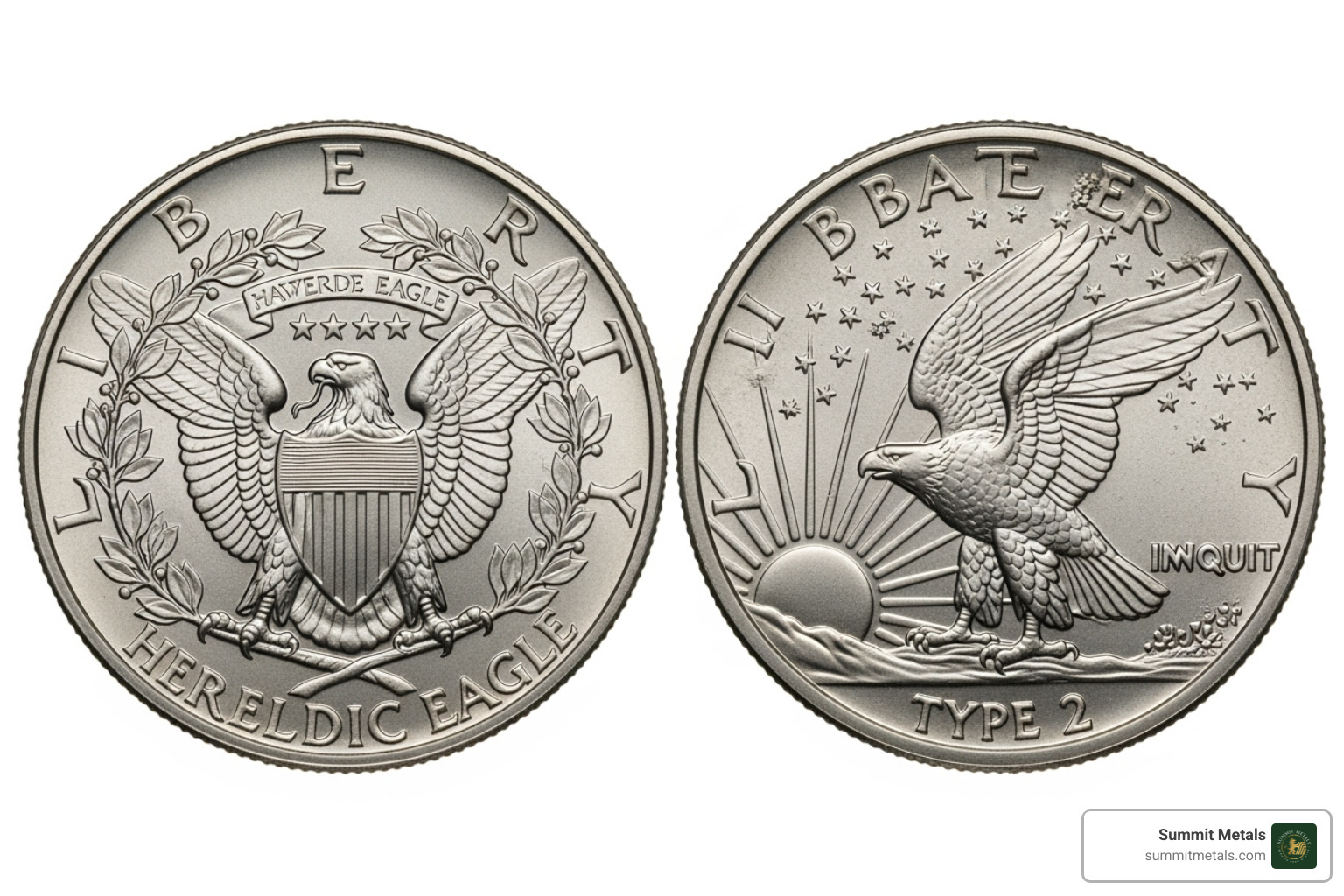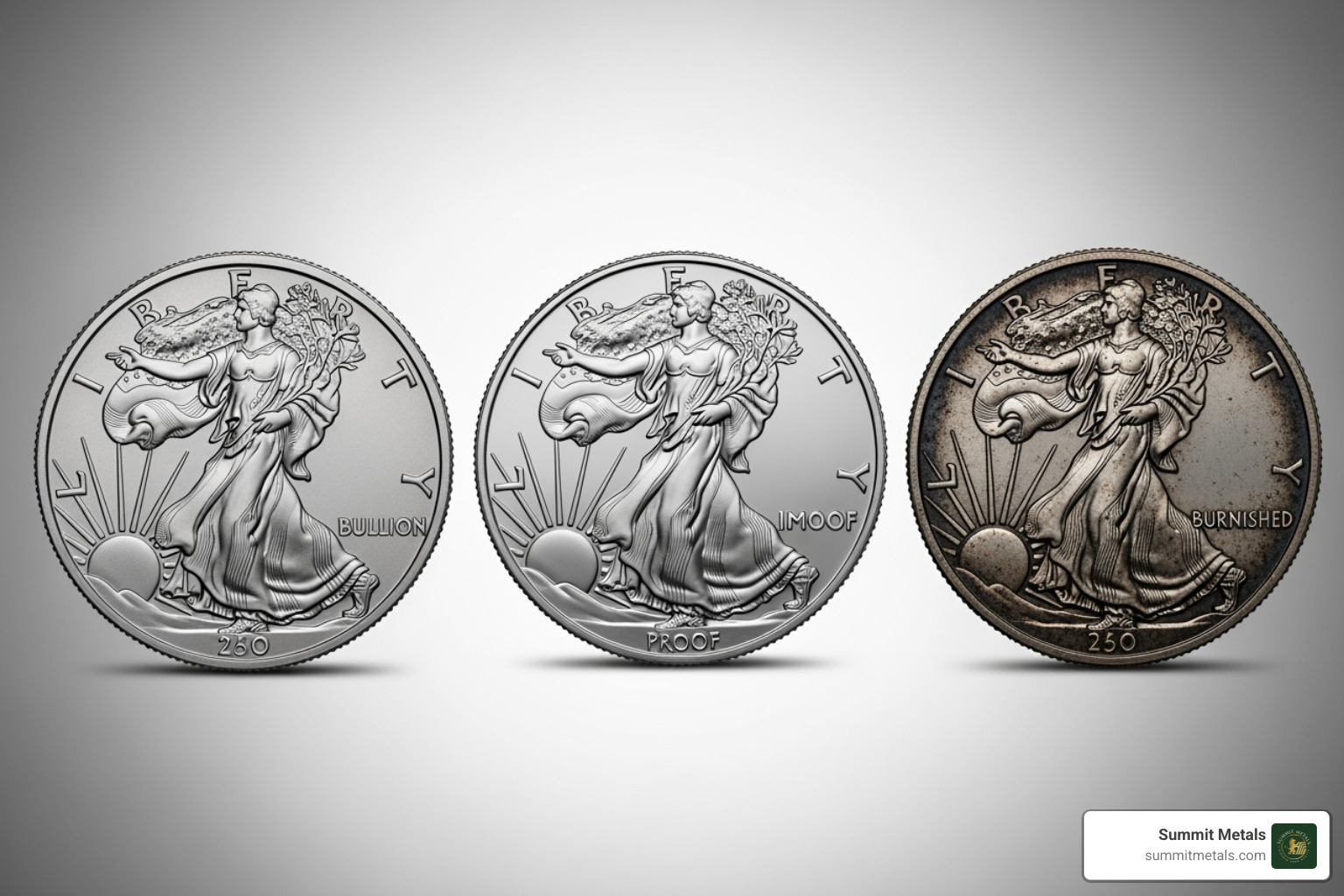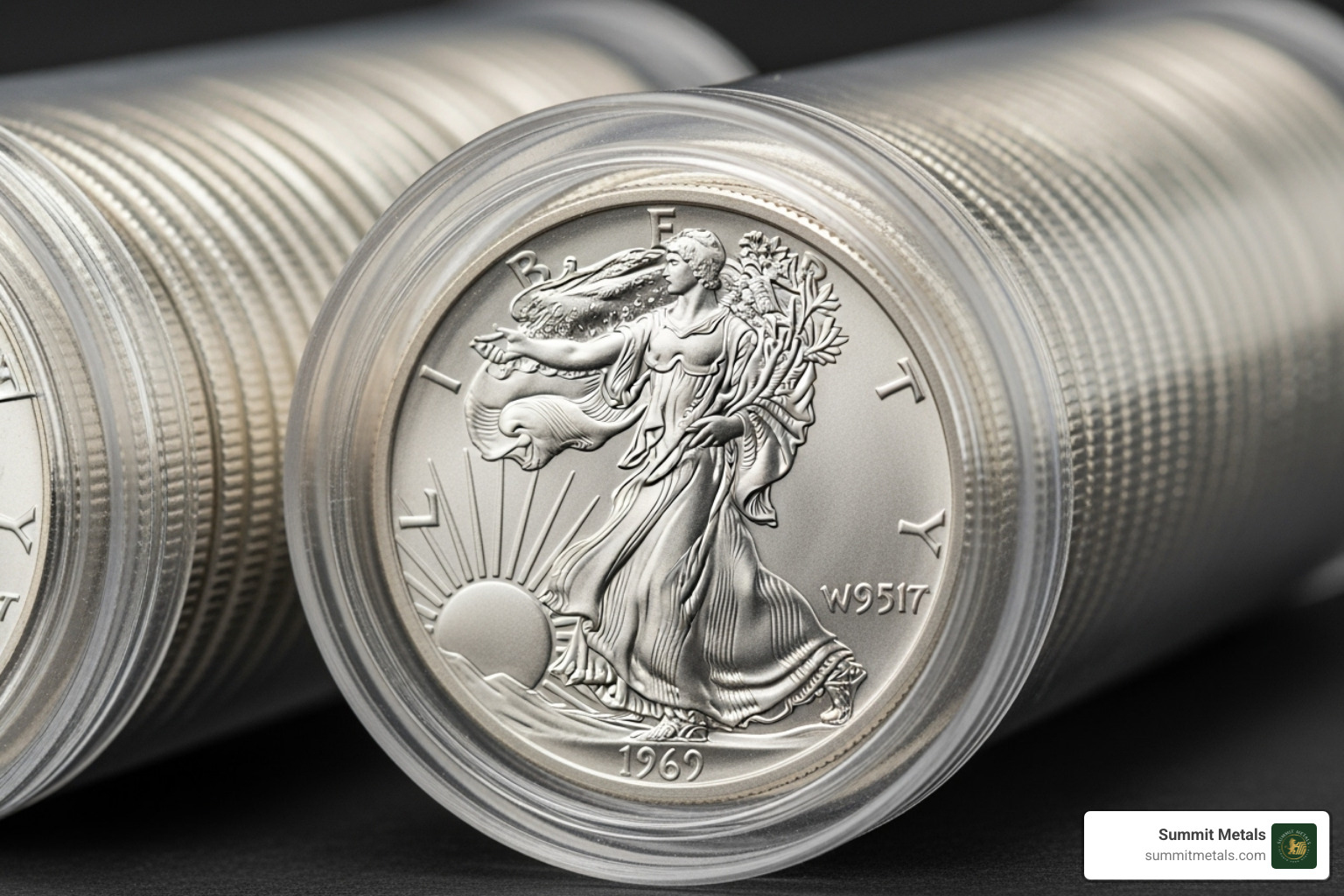Showing the American Silver Eagle Silver Dollar
From Law to Legend: The History and Design Evolution of the Silver Eagle
The silver eagle silver dollar blends smart policy, economic necessity, and timeless American art.
The Legislative Journey and Market Impact
In 1985 the U.S. needed to shrink its massive National Defense Stockpile of silver. Senator James McClure’s Liberty Coin Act of 1985, signed by President Reagan, solved the problem by turning surplus metal into bullion coins that citizens could buy.
The first coins left the presses on November 24, 1986, and they have served as a real-time economic barometer ever since. During the 2008 financial crisis monthly sales rocketed from 200,000 to 1,855,000. COVID-19 told the same story: a brief shutdown at West Point triggered a 240,000-coin emergency run in Philadelphia and sent premiums soaring. The episode also highlighted a fragile supply chain—the Mint still relies on a single supplier for blanks.
You can read the original legislation in The Liberty Coin Act of 1985.
The Original and New Designs
Adolph A. Weinman’s 1916 “Walking Liberty” commands the obverse, showing Lady Liberty greeting a new day with flag-draped confidence. For 35 years the reverse displayed John Mercanti’s heraldic eagle (Type 1). In 2021, to mark the series’ 35th anniversary, Emily Damstra’s more natural landing eagle (Type 2) replaced it, giving the coin fresh but familiar energy.

Advanced Security Features
Security has evolved along with the artwork. Traditional reeded edges deter silver shaving, and since 2021 an intentional missing-reed notch adds a quick, tool-free authentication aid that frustrates counterfeiters.
These safeguards, combined with government backing, keep the silver eagle silver dollar one of the most trusted ways to own physical silver.
A Collector's Guide to the Different Types of Silver Eagle Silver Dollar Coins
Think all silver eagle silver dollar coins are the same? Think again! While every American Silver Eagle contains exactly one troy ounce of .999 fine silver, they come in several distinct varieties that cater to different goals and budgets. Whether you're a serious investor focused purely on silver content or a collector who appreciates the artistry and craftsmanship, there's a Silver Eagle type that's perfect for you.
Understanding these differences isn't just about impressing your friends at coin shows (though that's a nice bonus). It's about making informed decisions that align with your investment strategy and collecting goals.

Bullion vs. Proof vs. Burnished: Understanding the Finishes
Let's explore the three main types of American Silver Eagles you'll encounter in the market today.
Bullion coins are the bread and butter of silver investing. These coins feature a brilliant uncirculated finish and are produced with one primary goal in mind: providing a cost-effective way to own physical silver. The U.S. Mint produces millions of these each year – for example, 16 million were minted in 2022 alone. Their value is tied directly to the silver content plus a modest premium, making them ideal for investors who want to stack silver without paying extra for fancy finishes.
Proof coins are where artistry meets precious metals. These beauties undergo a meticulous minting process that's quite different from their bullion cousins. The U.S. Mint uses specially treated blanks that are struck at least twice by polished dies, creating that stunning mirror-like background with frosted, raised design elements. The result? A coin with exceptional sharpness and luster that practically glows under the light.
Production numbers tell the story of their exclusivity. In 2022, only 1,066,517 proof Silver Eagles were produced – a fraction of the bullion mintage. This scarcity, combined with their superior craftsmanship, makes them highly sought after by collectors who value both the silver content and the numismatic appeal.
Burnished coins offer something completely different. Introduced in 2006, these coins showcase a distinctive matte-like finish that's achieved by striking specially prepared, often vapor-blasted blanks. The result is a subtle, sophisticated appearance that's neither mirror-bright like bullion nor reflective like proof coins.
Here's where it gets interesting: burnished Silver Eagles are produced in even smaller quantities than proof coins. Only 199,533 were minted in 2022, making them quite desirable for collectors who appreciate rarity. Unlike bullion coins, burnished Silver Eagles are sold directly from the U.S. Mint and typically carry a 'W' mintmark from the West Point Mint.
You might also encounter Reverse Proof coins, where the frosted and mirrored areas are flipped compared to standard proof coins, along with various special editions and collector sets that mark significant anniversaries or combine different finishes.
The Importance of Mint Marks and Rarity
Those tiny letters you see on some coins aren't just decorative – they're mint marks, and they can make a huge difference in a coin's value and collectibility. Originally used for quality control, mint marks now serve as important indicators of rarity and historical significance for collectors.
The West Point Mint (W) produces all proof and burnished American Silver Eagles. If you see a 'W' on your silver eagle silver dollar, you know it came from this prestigious facility in New York, known for its high-quality collector coins.
The Philadelphia Mint (P) has struck bullion American Silver Eagles, particularly during high-demand periods. Remember those emergency production runs during COVID-19 in 2020? Those special coins came from Philadelphia, adding a unique historical element to their story.
The San Francisco Mint (S) has also produced both bullion and some proof American Silver Eagles over the years, contributing to the diverse landscape of mint marks in the series.
Most bullion coins, especially those minted before 2021, carry no mint mark at all. This indicates they were produced at either the Philadelphia or San Francisco Mints for general bullion distribution.
Now, here's where rarity becomes really exciting. Some years and specific issues of the American Silver Eagle are particularly sought after due to their limited production numbers. The 2019-S Improved Reverse Proof holds the record for the lowest mintage of any Type 1 Silver Eagle design, with only 30,000 pieces produced. That's incredibly rare in the coin world!
Another standout is the 1995-W Proof, which had a mintage of just 30,125. What makes this coin even more special is that it was only available as part of a larger 5-coin gold and silver proof set, making it extremely difficult to obtain. These "key dates" can command significantly higher premiums than their more common counterparts – sometimes several times the price of a regular Silver Eagle.
Decoding Certified Coins: A Guide to Grading Your Silver Eagle Silver Dollar
When you're investing serious money in Silver Eagles, especially the rarer varieties, understanding certified coins becomes crucial. Third-party grading services provide an objective assessment of a coin's condition and authenticity, which can dramatically impact its value and your peace of mind.
The most prominent third-party grading services are PCGS (Professional Coin Grading Service), NGC (Numismatic Guaranty Company), and CAC (Certified Acceptance Corporation). These companies encapsulate coins in tamper-evident "slabs" after carefully evaluating them under magnification.
The grading system uses the Sheldon Scale, which ranges from 1 (poor condition) to 70 (perfect). A coin graded MS-70 (Mint State 70) or PR-70 (Proof 70) represents perfection – no visible flaws, even under magnification. Drop down to MS-69, and you might find a tiny imperfection that's only visible under close inspection. As you might expect, perfect coins command the highest prices.
When you buy a "slabbed" coin, you're getting more than just the coin itself. You're getting a guarantee of authenticity and precise condition assessment. This eliminates the guesswork and provides confidence in the coin's market value, which is especially important in a world where counterfeiting is an ongoing concern.
Some certified coins carry special designations that can add to their premium. First Day of Issue (FDI), FirstStrike®, or Early Release labels indicate that the coin was submitted for grading within a specific timeframe after its initial release. Even Emergency Production labels, like those seen on some 2020 Philadelphia-minted coins, add a unique historical element that collectors appreciate.
CAC started certifying coins directly in 2023, adding another layer of stringent grading standards to the market. This gives collectors and investors even more confidence in their purchases, knowing that their silver eagle silver dollar has been thoroughly authenticated and graded by multiple expert services.
Investing in Silver Eagles: Premiums, Value, and IRA Eligibility
The silver eagle silver dollar isn't just a beautiful piece of art; it's a serious investment. For anyone looking to add precious metals to their portfolio, it's crucial to understand how its price is determined, why it's such a valuable asset, and even how it can fit into your retirement plans.

What Determines the Price of a Silver Eagle Silver Dollar?
When you buy an American Silver Eagle, you're not just paying for the silver itself. Think of it like buying a fancy car: you pay for the engine (the silver), but also for the brand, the design, and the journey it took to get to you. The total price you pay for a silver eagle silver dollar is generally made up of two parts: the current silver "spot price" and a "premium."
The spot price is simply the market price for one troy ounce of raw silver. It changes constantly, like stock prices. The premium is the extra cost added on top. This covers all the hard work that goes into making and distributing the coin. Things like minting costs, distribution fees, and what the dealer charges all contribute to this premium.
Premiums on American Silver Eagles can swing quite a bit, much like a seesaw, depending on a few key factors:
- Mint Production Levels: Even though the U.S. Mint works hard, they can't produce an unlimited number of coins. If fewer coins are made in a given year, or if a certain type (like a proof or burnished coin) has a lower mintage, that scarcity can push premiums higher.
- Supply Chain Limitations: We saw this clearly during the COVID-19 pandemic. The U.S. Mint relies on a single supplier for their silver blanks. When that supply chain faced issues, it created a bottleneck. With fewer blanks available, but lots of people wanting coins, premiums shot up! At one point, premiums for Silver Eagles soared to an astonishing $20 over the spot price. That's nearly double what you might pay for some other silver coins.
- Authorized Purchaser Network: The U.S. Mint doesn't sell bullion coins directly to us. Instead, they sell in huge batches (at least 25,000 coins!) to a special network of "authorized purchasers." These purchasers then sell to retailers like us, and finally, we sell to you. Each step in this process adds a little to the premium.
- Investor Demand Spikes: When the economy feels wobbly, or people worry about inflation, many turn to physical precious metals like silver. We saw this in 2008 during the financial crisis and again during the pandemic. A sudden rush of demand, where everyone wants silver but there's not enough to go around, sends premiums soaring.
- Collectibility: For serious collectors, rarity is king! A coin's condition and how hard it is to find can hugely impact its value. For instance, a complete set of 39 American Silver Eagles (from 1986 all the way to 2023, including the Type 1 and Type 2 designs from 2021) can fetch a premium of over 100% above the silver's spot price! Older silver eagle silver dollar coins often become even more valuable after new designs are released, simply because their production numbers are fixed, making them scarcer.
Prices shown are at the time of this publication.
Why Silver Eagles are a Cornerstone Investment
The American Silver Eagle is much more than just a shiny piece of silver; it's a powerful tool for your financial future. Many investors consider it a solid foundation for their precious metals portfolio, and here's why:
First off, there's the U.S. Government Guarantee. Every silver eagle silver dollar is backed by the United States government for its weight and purity. This isn't just a nice-to-have; it instills immense trust and confidence. It's why this coin is one of the most recognized and widely traded silver bullion coins in the entire world. When you hold an American Silver Eagle, you know exactly what you've got.
Then there's its High Recognizability and Liquidity. Because it's so famous and trusted, the American Silver Eagle is incredibly easy to buy and sell, no matter where you are. This high liquidity means you can convert your investment back into cash relatively quickly if you ever need to. It's almost like universal currency in the precious metals market!
Historically, physical silver, like the silver eagle silver dollar, has proven to be an excellent Hedge Against Inflation. When the cost of living goes up, or when traditional paper assets like stocks and bonds feel shaky, tangible assets often hold their value or even increase. It's like a financial safe harbor in stormy economic seas.
In a world that's becoming more and more digital, owning Tangible Assets like silver offers a unique sense of security and control. You can physically hold it in your hand. It's free from the risks associated with digital systems, like cyberattacks, or the uncertainties of third-party defaults.
While there are other excellent silver coins from around the world, like the Canadian Maple Leaf or the British Britannia, the American Silver Eagle often commands a slightly higher premium. This is largely due to its immense popularity and the rock-solid guarantee of the U.S. Mint. It also stands apart from non-sovereign silver options, like the Silver Buffalo, which are produced by private mints. Because the Silver Eagle is U.S. government-backed legal tender, it generally carries a lower risk of counterfeits and is more widely accepted.
For us at Summit Metals, the American Silver Eagle embodies our promise: to provide you with transparent pricing and authenticated silver for your investments.
Including Silver Eagles in Your Precious Metals IRA
Did you know that American Silver Eagles can actually be a part of your retirement strategy? It's true! They are eligible for inclusion in precious metals Individual Retirement Accounts (IRAs), as long as they meet specific IRS standards.
The main requirement for silver coins in an IRA is that they must be incredibly pure – specifically, .999 (99.9% pure silver). The great news is, the American Silver Eagle easily meets this requirement! This means you can use these coins to diversify your retirement portfolio beyond just traditional stocks, bonds, and mutual funds. It adds a valuable layer of tangible asset security to your long-term savings.
Adding physical precious metals like the silver eagle silver dollar to your IRA can be a very smart move for long-term wealth preservation. It helps protect your retirement savings from market volatility and inflation, making your overall portfolio more balanced and resilient. We always suggest chatting with a financial professional to see how precious metals IRAs might fit into your unique financial plan. For all the nitty-gritty details on what the IRS allows, you can check out IRS Publication 590-A on IRA contributions.
Frequently Asked Questions about the American Silver Eagle
Got questions about the American Silver Eagle? You're in good company! We hear a lot of great questions, especially about its unique name and the different versions available. Let's explore some of the most common ones and clear up any mysteries.
Is a Silver Eagle the same as a historic silver dollar?
This is a fantastic question, and one that often causes a little head-scratching! While you might hear people affectionately call it a "silver eagle silver dollar" – thanks to its $1 face value – it's actually quite different from the old silver dollars you might remember.
Think of historic U.S. silver dollars, like the classic Morgan Dollar (minted from 1878-1921) or the beautiful Peace Dollar (1921-1935). These coins were the real deal for everyday spending. They were designed to circulate, and they contained about 90% silver. They also had their own unique weights and sizes.
Now, the American Silver Eagle is a much newer coin, first introduced in 1986. Its main job isn't to be spent at the corner store! Instead, it's a modern bullion coin, packed with a full troy ounce of .999 fine silver. Its purpose? To be a solid investment. So, while it carries that familiar '$1' value, its true worth, tied to the silver market, is always much, much higher. It's a dollar in name, but a powerhouse of silver in practice!
What is the rarest and most valuable Silver Eagle?
Ah, the hunt for the truly special! When we talk about the rarest and most valuable American Silver Eagles, a couple of stars really shine.
The 1995-W Proof Silver Eagle often takes the top spot. Why? Because the U.S. Mint only made a tiny number of them – just 30,125 pieces. What makes it even more unique is that you could only get it as part of a special 5-coin gold and silver proof set. This makes it a real gem for collectors who are keen on completing their sets.
Another low-mintage marvel, especially for those who love the original Type 1 design, is the 2019-S Improved Reverse Proof. This beauty had an even lower mintage, with only 30,000 ever produced!
These incredibly low production numbers create true scarcity. And as any good collector knows, scarcity is what often drives up value in the market. These are definitely the kind of treasures that get collectors excited!
How are Silver Eagles produced and packaged?
Ever wondered how these beautiful coins come to life? The American Silver Eagles are lovingly created by the incredible team at the United States Mint, across their facilities in West Point, Philadelphia, and San Francisco.
It all starts with a perfect, one-troy-ounce blank of .999 fine silver. These blanks then get a powerful squeeze from massive presses, which imprint those iconic "Walking Liberty" and eagle designs onto the metal. For the extra-special proof and burnished coins, there's even more care involved, like polishing the dies and preparing the blanks in unique ways to get that stunning finish.
Once minted, these precious coins are handled with kid gloves to keep them pristine. If you're buying just one silver eagle silver dollar, it'll likely come in a clear, protective plastic flip. But for those looking to add more silver to their stack, the U.S. Mint has some clever packaging solutions:
- Mint Tubes: These handy plastic tubes neatly hold 20 coins, keeping them safe and sound from bumps and environmental wear.
- Monster Boxes: For our serious investors, there's nothing quite like the legendary green "Monster Box." These robust, sealed containers are a sight to behold! Each one holds 25 of those mint tubes, adding up to a grand total of 500 American Silver Eagle coins. It's the ultimate way to store a significant amount of silver, securely and efficiently.
Conclusion: Why the Silver Eagle Belongs in Your Collection
After exploring the series, one thing is clear: the silver eagle silver dollar is much more than a $1 coin. It carries U.S. government guarantees, world-class artistry, and a proven track record as a crisis-era safe haven.
Whether you are:
- a saver who wants low-premium, highly liquid bullion,
- a collector chasing perfect proofs and key dates, or
- a long-term planner adding tangible assets to an IRA,
the American Silver Eagle checks every box.
At Summit Metals we pair these advantages with the transparency you deserve—real-time pricing and authenticated inventory shipped worldwide from our Wyoming headquarters.
Ready to secure a piece of American history? Explore our collection of American Silver Eagle coins and start building your stack today.






